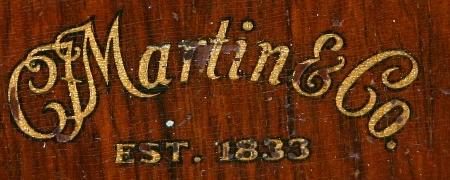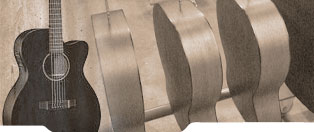
In My Life
What do George Harrison and Mark Twain have in common? … Both men had Martin Guitars.
In 1833, Christian Frederick Martin established C.F. Martin & Co., as a U.S, guitar producing company. He immigrated to New York City from his native Germany. Today, the sixth generation of the Martin family; Christian F. Martin IV heads the company. He is the Chairman and CEO of Martin Guitars. For over 178 years, a person with the initials, CFM has been in charge of producing what is considered to be one of the finest, if not THE finest steel string guitars in the world.
On a rainy and overcast day in May arriving in Nazareth, Pennsylvania, I had the pleasure of visiting the Martin Guitar factory with my wife Barbara and our friends, Mary & George. What made the journey to Nazareth even more special was that we toured the factory with Chris Martin, Chairman & CEO of the company. Chris graciously showed us around the factory exhibiting both incredible knowledge of how a guitar is properly built and great pride in the workmanship that goes into every musical instrument bearing his family’s name. He treated us to a once in-a-lifetime opportunity to see how this unique company is able to produce musical instruments coveted by every professional (and non-professional) guitar player throughout the world.
At the company’s headquarters in Nazareth, Pa., in the main lobby, there is an entire wall devoted to displaying an excessive amount of album covers devoted to artists that have used Martin Guitars on their records. In some cases, the album cover shows the artist proudly holding a Martin guitar. Johnny Cash, Willie Nelson, Eric Clapton, Crosby, Stills & Nash (individually and collectively), Rick Nelson, Paul Simon, Paul McCartney, Sheryl Crow, Elvis Presley are all represented as artists that have used or currently using Martin guitars including far too many more to mention.
On the other side of the lobby is the Martin Guitar Museum. In it are pictures, vintage guitars and memorabilia devoted to the history and production of these prized possessions. One of the photographs in the museum that caught my eye was a picture taken in February, 1968 through a chain link fence in Rishikesh, India by photographer, Paul Saltzman. It is a picture of John Lennon and Paul Mc Cartney each playing their Martin guitars. Paul is said to be singing “Ob-la-di, Ob-la-da, how the life goes on” John has just joined in and for 15 minutes they just sing those words over and over. Halfway through, they paused and Paul looks up and says “That’s all there is so far, we don’t have any of the words yet.” A moment in musical history.
In October, 2009, a Martin D-28 that was played by Elvis Presley in his last concert in Las Vegas sold at auction for $106,200.
We began the tour by looking at the wood that is used for the Martin guitars. Chris explained that the best wood to be used to build the back and the sides of the guitar is Brazilian Rosewood. He told us that is the wood of choice for the true guitar professional since it is widely acknowledged for creating a superior sounding guitar. Unfortunately, this wood is now very rare. It’s harvesting is closely protected by the Brazilian government and it is actually illegal to cut down these trees without permission. In its place, Rosewood from India and Madagascar is now being used. Rosewood is considered the premier tone wood, but mahogany is also preferred and Martin now uses spruce from Western Canada and southwestern Alaska.
Chris explained that when they cut the wood and take a whole log and cut it in half. They then take that log and cut it in half again to make it in quarters. They slice the veneers out of the quarter and what they are looking for is straight grain that is running through the wood. That is the best way to cut the wood in terms of support and structure for the guitar.
Once the wood is cut, it needs to be put in a temperature controlled room on a palette with sticks in between so that air can circulate. The company is looking to have a 68% moisture content into the wood. It sits in the room at 72 degrees, 45% humidity for two years
D-45: A luxuriously ornamented version of the “D-28.” First made for Gene Autry. Pre-World War II D-45s (only 91 were made) are the most expensive guitars in the United States.
We spent some time looking at the material used for the inlays, called the rosette that is present in virtually all guitars. I was under the impression that ivory was the material used. According to Chris, “years ago they used ivory and tortoise shell, but not anymore.” Yes, the replacement material being used today is plastic, although it does “look like” ivory. Once in a while people will contact Chris and tell him that they have ivory to sell him. He flatly refuses to use that material since the use of ivory is pretty much illegal.
We were told that in the 1930’s, the company went from gut guitar strings to steel strings and that event ushered in the invention and development of the modern western guitar.

Roger McGuinn, founding member of the Byrds worked with C. F. Martin & Company to develop a seven-string folk guitar. McGuinn’s guitar (the D7) is tuned the same as a standard folk guitar with steel strings, but the third (G) string is augmented with a harmonic string one octave higher. The intention was to offer the six-string player the chance to play “jangly” twelve-string style lead guitar.
It takes anywhere from 6 weeks to three months to make a guitar. It can cost anywhere from $700 to $110,000 to buy a Martin guitar. Chris has two manufacturing plants. One facility is in Nazareth, Pennsylvania and the other in Mexico. He has been able to combine old world craftsmanship with modern technology at both places. He has been able employ people who are devoted to their craft. Naturally, in any business, a good CEO knows that technology is constantly changing and in order to survive, you need to embrace the change or your competitors will overtake you.
As a businessman, Chris became the CEO and Chairman through a rather circuitous route. At a young age, he lived for a while with his grandfather. He said that the two of them spent many hours speaking about the business and what it meant to his grandfather. Chris told me that when he eventually succeeded his father as head of the company, the conversations he had with his grandfather years earlier were invaluable to him.
What struck me was the fact that he has employees working in Nazareth that have been with the company for many years. Naturally, there are some jobs that require specific craftsman skills. However, for the times he purchases new equipment to increase productivity, he tells his co-workers that their current job is evolving. He says, “I would like you either learn a new job or I will teach you another job.” And since he first had that type of conversation with the workers twenty years ago, they have not laid off any employees. People of course move on or retire, but the bottom line is that the Martin family values their workers and by the way, employees of Martin guitars receive a share of the profits.
Eric Clapton plays a 000-42 style Martin Guitar
The tour of the plant took us through every step that included cutting the wood, matching a front and back of the guitar, constructing the sides, attaching the neck and fingerboard, polishing, adding the bridge and saddle, more polishing, attaching the strings, tuning the instrument and having applying yet another layer of quality control. There are people at the Martin factory whose job it is to play the finished guitar to make sure it sounds right.
Willie Nelson’s 1969 guitar, affectionately named “Trigger” is an N-20 Martin and he has no intentions of ever replacing it.
Running a company is an awesome responsibility. It takes skill and although one might say that you need a MBA degree from an accredited University School of Business to successfully run any large company. I say that’s true, but you also need common sense. Chris told the story of attending an industry Trade Show. A guy walks up to him and asks, “Can you tell me why everybody in this industry charges a premium price for a left-handed guitar? You guys are penalizing me. I was born this way!” So, Chris came back to the factory the next day and decided that it made no sense to charge more for a left-handed guitar and changed that policy. I suggested that he charge McCartney more for his left-handed guitars, but Chris rejected that idea.
In 1997, Martin launched its “Women in Music” series, which was followed in 1998 by the Joan Baez Signature guitar, a replica of the 0-45 Baez began her career with.
Martin guitars are guaranteed for life. Short of the guitar being run over by a car, they people at Martin will gladly accept of the damaged instrument and always repair their guitars. Martin is the largest manufacturer of high-end acoustic guitars in the world.
I was interested to know if any of the rock stars who use Martin guitars have ever visited the plant in Nazareth. Unfortunately, those visits out to the hills of Pennsylvania are few and far between. Usually what happens is that a representative from the Martin Artist Relations’ department travels to New York or wherever the artist is appearing to see and confer with them.
My favorite story involves the crown jewel of Martin Guitars, the D-45. Apparently, there were no D-45 models in the museum to display. At one point, Chris was offered an opportunity to purchase one, but the cost was well over $200,000 and the company was not in the financial position at that time to make that expenditure and he had to let it go. Years later, finances improved and Chris was once again given the opportunity to buy a D-45. This time the cost was approximately $250,000. He went to his Board of Directors and conferred with them on the purchase that D-45., even though as Chairman he could have made the purchase anyway and now that D-45 sits proudly in the Martin Museum.
Now that the company is doing well, Chris would like to make the transition from CEO & Chairman to just being Chairman. He’s been the CEO since 1987 and feels it’s time to devote his energies in other areas. He has done a remarkable job of blending old world wood working skills with modern robotic machines that produce exceptional instruments.
If I could choose what to come back as, it would be a Martin OM-45……Eric Clapton


No Comments comments associated with this post